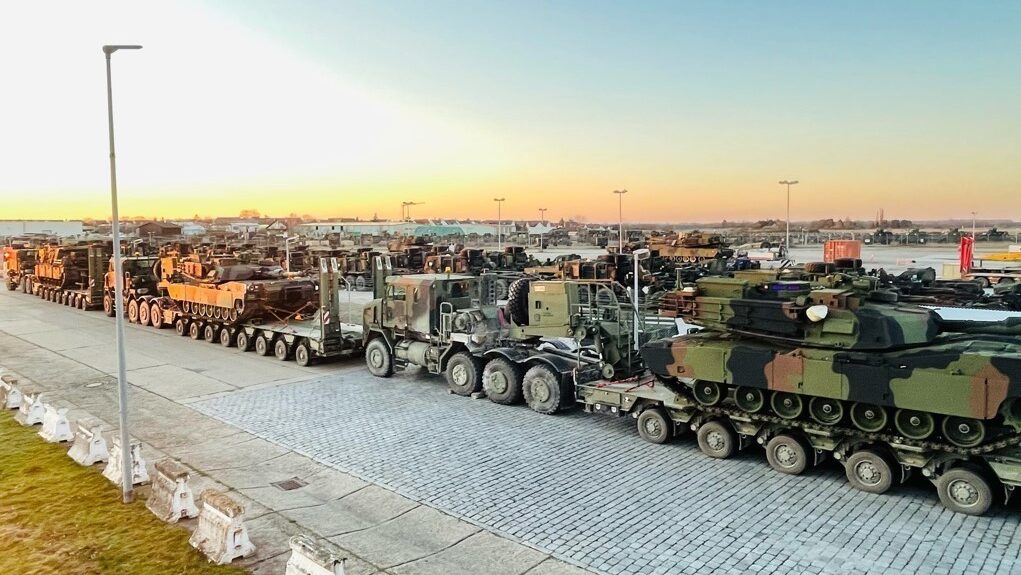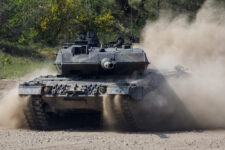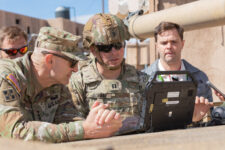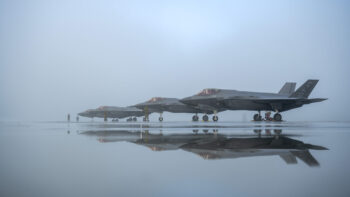
A line of military Heavy Equipment Transport line-haul trucks is staged at Coleman work site in Mannheim, Germany, part of Army Prepositioned Stock-2 (US Army/Maj. Allan Laggui)
GLOBAL FORCE 2024 — After a sudden leadership shake up at Army Materiel Command, its deputy, Lt. Gen. Christopher Mohan, has stepped in to perform the duties of his boss — and says planning is moving forward on prepositioning stockpiles throughout Europe and the Indo-Pacific region.
“This is a difficult time but I’ve got a great team: I’ve got great support from the secretary and the chief [and] I’ve got all the authorities I need,” the three-star general told Breaking Defense on Wednesday. “We’re driving the organization forward [and] my message on Monday morning was, ‘Operations normal.’”
On March 22, Army Secretary Christine Wormuth suspended AMC head Gen. Charles Hamilton. pending an investigation. The move was spawned by a Military.com report that he may have inappropriately intervened in an assessment panel’s work to help a subordinate officer. Those events unfolded just days before senior Army leaders and industry descended on the AMC’s home in Huntsville, Ala., for the annual Association of the US Army’s Global Force symposium. Hamilton’s planned keynote speech was swapped out for one by Mohan, and the show went on.
While it isn’t clear how long Hamilton’s investigation will take or what the findings will be, Mohan said it’s full-steam ahead on a variety of fronts, including finding new locations to place Army Prepositioned Stocks (APS) inside the European and the Indo-Pacific regions.
Right now In Europe, the service has two APS sites in Germany and spots in the Netherlands, Poland, Belgium and Italy. But as the war inside Ukraine wages on, and Finland and Sweden are now NATO’s newest members, more sites are needed, especially in the high north.
“The addition of the NATO partners changes the security landscape and our responsibilities as part of NATO,” Mohan said, noting that the service is homing in on just what equipment and locations are best for the high north and Arctic.
US European Command head Gen. Christopher Cavoli, he added, is spearheading some of those changes and crafting a plan that will “embrace and integrate Finland and Sweden into the NATO enterprise, and that’s going to drive some changes on the ground.”
While Mohan didn’t disclose possible new site locations in Europe, Maj. Gen. Ronald Ragin — the commanding general for the 21st Theater Sustainment Command tasked with Army Europe-Africa — said on Tuesday that Norway is one option. However, he cautioned that the diplomatic process necessary to iron out such deals takes time and can be littered with roadblocks.
“That’s why I asked, if I had two years yet before a conflict, where would I be? And so we’re working those agreements very hard … [and] the Army is making investments in APS, specifically, modernizing,” the two-star general told Breaking Defense.
Nailing down such deals is even more complicated in the Indo-Pacific region where a NATO-like alliance doesn’t exist, and the US leans on individual bilateral agreements.
The Army’s current stockpile to support that region includes equipment stored on its floating APS and equipment in Australia. But even with all that combined, Mohan said it’s not adequate for the region. Instead, US Army Pacific, in conjunction with other service leaders, is developing options for other potential ground-based APS locations.
“This is the tyranny [of] transportation … everything’s eight hours [away] there,” he said. While having more ground-based APS sites is good for the US, Mohan cautioned such deals increase the host nation’s “exposure” to retaliation from countries like China. The US also has to weigh the costs of maintaining such sites.
As for when that plan may be wrapped up, Mohan said it isn’t clear.
“It is an iterative, with decision and risk points along the way,” he added. “Our job is to develop options, and then clearly articulate the risk.”
“A risk point would be, hey, look, we’ve got warehousing, but we don’t have humidity control yet, which is who requires to touch it more often, which is going to cost more money. But if that allows us to shorten a transportation timeline, is it worth the risk?” the three-star general added.






















